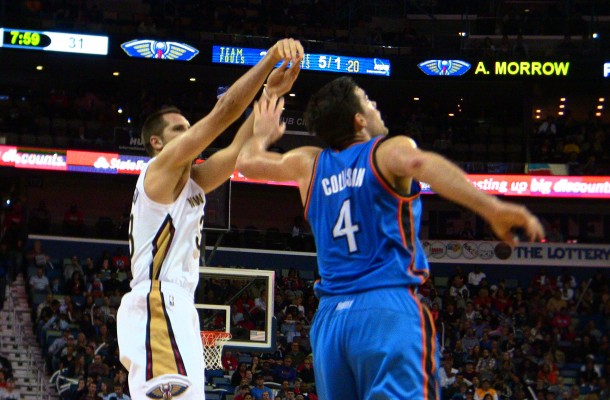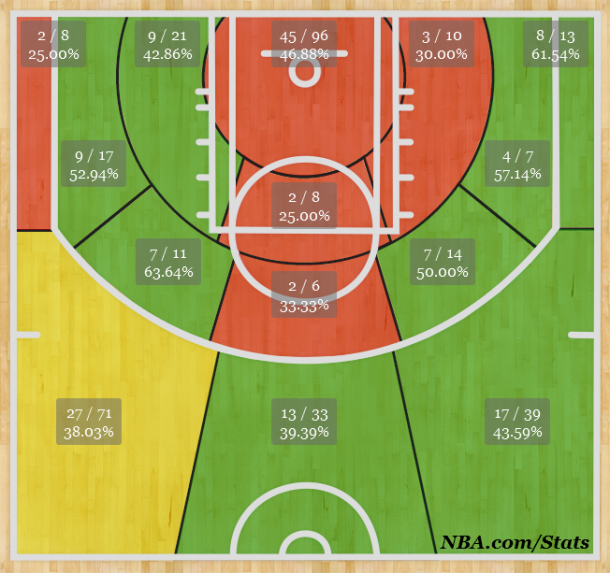22 games. That was all we saw of Ryan Anderson this season. Luke Babbitt played in 27 games. Little used Darius Miller played almost the same number of total minutes. It was rough for us as Pelicans fans, but for him, it must have been a nightmare year. His off-season was tragic. He got injured right before the season started, came back and found his groove – and then got leveled with a truly scary injury. Almost two months after the initial injury, he was a guest on the broadcast and told Joel Meyers that the pain was finally receding. Two months afterwards. Ugh.
With the injuries and few minutes, it’s hard to judge Ryan Anderson’s season. Sure, he hit a career-high shooting percentage from deep while taking more threes per game than he’s ever managed before – but it was a small sample size. Still, I’ll try to pull a few conclusions from the mix.
Was he better than the year before?
Partially. Overall his production became less diverse as he became more focused on being a perimeter finisher. His previous season in New Orleans had seen dips in both his eFG% and his TS%. Those numbers returned to what he enjoyed in Orlando. His turnover rate fell to an insanely low rate I’ve never seen before on a high usage player (4.1%) – though that corresponded with an assist rate that also was sub 5%. Eesh.
Anderson’s rebounding also declined from the year before. Though his offensive glass work stayed static, his defensive rebounding dropped 6% – a major dip – and both numbers were well below his rebounding highs in Orlando. His shot distribution stayed about the same. He took about a quarter of his shots at the rim, 45% of them from deep, and everything else in between. Those numbers are only 1% off in each category from what he shot last year.
Oh, but those shots. I’m a sucker for a good shooter. Here’s his shot chart:
The only place he shot worse than the previous season was at the rim – where he declined 7% from the field. (I almost find myself not caring because of all the other nice green in that chart. Dude is even murder from the dumb zone!)
What is the result? His spacing and high-volume, high-efficiency shooting spurred the highest team offensive rating from someone who played more than 500 minutes and isn’t Luke Babbitt. When Anderson played, the team scored 110.8 points per 100 possessions. The best offensive team in the league averaged 109.4 this season.
It’s actually pretty crazy looking at line-up data with Anderson. He was responsible for kick-starting all kinds of line-ups on the offensive end. In fact, only one lineup he spent more than 10 minutes playing with posted an offensive rating under 108.0. (That lineup? Davis-Anderson-Aminu-Morrow-Holiday. Scratchin’ my head here.) Anderson is offensive grease lightning.
The Defense
Let’s not kid ourselves here. I find myself trying to dismiss Ryan Anderson’s defensive shortcomings because his offense and spacing is so damn significant. I like to pretend that since Anthony Davis frequently was his replacement on the court – or Aminu – and they were decent defenders, his plus-minus numbers look skewed. Really, that’s just putting lipstick on a pig. When Anderson played, the Pelicans gave up 109.1 points per possession. If I give him kudos for being offensive lube (think he’d like that as a nickname?) I have to kill him for what happens on the other end of the court when he plays.
Here’s the Defensive categories in which the Pelicans performed worse than normal when Ryan Anderson played:
- Opponent FG%
- Opponent 3P rate
- Opponent OReb%
- Opponent Assist %
- Opponent Block %
Here’s the categories where the Pelicans performed better:
- Opponent FT Rate
- Opponent 3 PT %
While there is some value in not fouling, that’s a small thing to hang your hat on. Particularly when being better than the Pelican’s average at fouling is faint praise – and the 3PT% is probably a fluke. I’m sure there are some people who will spend time looking at Anderson’s Synergy stats and try to use them to prove Anderson isn’t that bad. If he’s the primary on ball defender – he’s actually not so bad. But his help defense is simply atrocious – and NBA defenses are help-centric.
Watch him try to defend the lumbering Jared Sullinger after a brief scramble here:
Or his defense on Avery Bradley a few minutes later here:
He’s just not quick enough, and he’s being asked to defend some perimeter players because of how he plays on the offensive end. It’s a problem – and having a big man as a defensive liability can be inordinately damaging to a team defense. Much worse than a weak wing or guard – who can be helped by talented big men behind them. In the end, only one player on the Pelicans who was expected to play minutes had a worse defensive rating this season than Ryan Anderson. (Hi Eric!)
Moving Forward
Based on standard estimates and other athletes with similar injuries, Ryan Anderson should be fully recovered from his injury for next year. Whether he should be considered a core piece of the team or not is an entirely different question. How do you rate a guy who brings so much to the table, yet takes so much away at the same time? Can the Pelicans cover for his biggest deficiencies? As of right now, I’d say no, since the team has two above average defenders slated to return to the team next year. That can change, but it’s still something Dell will have to take into consideration as he fills in the team.
Regardless the Pelicans are in a good spot with Anderson. His contract is reasonable, they can let him come back and see how he fits when the team gets some time to gel together. Everyone loves a stretch four right now in the league, and if the team doesnt gel, Demps has a poor man’s Kevin Love on a great contract he can use as a trade chip – and until that trade works out, guaranteed offensive fireworks every night.
I can live with that.
For all the Season in Review pieces, click here.


7 responses to “Season in Review: Ryan Anderson”
The help defense thing is weird. He got run in Orlando under Van Gundy on some very good defenses. Van Gundy wouldn’t have played him if he were clueless. Is it scheme or not having Howard behind him?
thouse Honestly, the more I watch of his defense – he was still playing for the Pelicans when they were asking all their bigs to hedge hard on pick and rolls. He doesn’t really have the footspeed to hedge and get back to his man if they roll hard or flare. I don’t know what Van Gundy did with Anderson since most of the sites I use just started recording play by play video this year or last year. I would bet Anderson was told to be more conservative though and not be forced to scramble.
It appears to me that Monty wanted his bigs to show hard and recover. That’s the ideal way to defend pick and rolls – if you have the personnel. Later, when he had to use Ajinca, he ended up relaxing that rule and having them fall back more conservatively. Maybe that’s how they have to use Anderson too.
I think Anderson’s defensive shortcomings explain why he came off the bench to start the season; it’s easier to play defense against 2nd team bigs. (Anderson can still play minutes with the 1st team in the right spots.) But that thought (Anderson not starting) means AD starts at PF ’cause he isn’t a C (which I agree with). So who starts at C next year? Ajinca? Someone else?
xman20002000 504ever
To me, who starts at C and SF are the Issues for Next Season (again).
Agree. SF a bigger issue though.
adfly
And easier to fix.
504ever I think the main issue with Anderson coming off the bench (aside from Brow being our starting PF of course) was that Tyreke was also coming off the bench and Anderson spreads the floor for him.
Great point about the defensive shortcomings though.